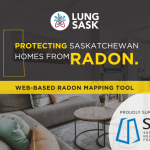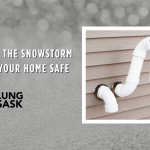Radon: Is it Lurking in Your Home?
Radon is a colourless, odourless, radioactive gas. It occurs naturally in the environment as a result of the breakdown of uranium found in soil and rocks. In the outdoor air, radon is diluted and is not a health risk. Radon can seep from the ground into buildings through the foundation, basement windows and the plumbing system. If radon seeps into an enclosed space such as a house or apartment building it can build up to levels that are a health risk.
Radon is the second leading cause of lung cancer, behind only smoking. Radon exposure accounts for 10% of all lung cancers. People who smoke and who are also exposed to radon have an even greater risk of developing lung cancer. Lung cancer kills more Canadians than breast, colorectal and prostate cancers combined.
We are urging Canadians to test their dwellings for radon. Testing devices are inexpensive and can be purchased from The Lung Association for $50, which also includes the analysis from the Saskatchewan Research Council. It is recommended that testing be done for a three month period, preferably during the winter months. Current Health Canada guidelines recommend lifetime levels of radon exposure be less than 200Bq/m3.
Testing should be carried out in the lowest level that is normally occupied for more than four hours per day. In a house this may be a finished basement or the main level if the basement is only used occasionally. It is recommended that apartment buildings be tested below the third level, although radon has been known to travel through elevator shafts and air ducts to higher floors.
Reducing radon levels in a property can be simple. Actions such as filling foundation cracks, sealing foundation walls, installing proper floor and sump pump covers and increasing ventilation may be all that is required. In cases of high levels, the ground beneath the foundation may need to be depressurized. Professional help may be needed for that work. The cost of repair can run from $50 to $3000, depending on the level of radon found in the building. If you are building a new home, we urge you to talk to your home builder regarding upfront planning to address Radon.
This is just one of the many ways that The Lung Association of Saskatchewan is working to improve air quality for the residents of Saskatchewan. You are invited to join with them in their mission to improve lung health. A great way to get involved is to purchase a ticket for the 2012 Share The Air Raffle. Your support could land you the grand prize of up to $120,000 (based on 25% of gross ticket revenue) or one of the other 84 prizes (total prize board retail value of up to $158,000). Tickets are one for $35, two for $60, or (the best deal) four for $100. Only 16,000 tickets will be sold. To purchase yours, call our toll free, 24?hour raffle hotline at 1?866?95LOTTO (1?866?955?6886) by midnight on May 25th. The draw will take place on June 1st. Lottery License #LR11?0070 (intended for Saskatchewan residents only).
Breath is life. We can live a long time without food, a couple of days without water, but life without breath is measured in minutes. Something so essential deserves our attention!



